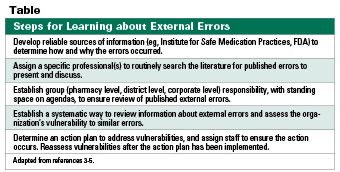Medication Safety: Using External Errors to Uncover Potential Dangers
Pharmacists need to not "normalize" stories of tragic events that occur in the pharmacy; rather, pharmacists must learn from the mistakes of others, and take in important information, to ensure the mistakes do not recur.
Pharmacists need to not "normalize" stories of tragic events that occur in the pharmacy; rather, pharmacists must learn from the mistakes of others, and take in important information, to ensure the mistakes do not recur.
Chances are you have scanned the headlines and read many of the stories about medication errors published in the literature, particularly the tragic error like the death of an elderly patient from the misprescribing of a fentanyl patch. While reading these stories, you have probably felt surprised or startled, saddened, unsettled, and perhaps even angry. Unfortunately, we have a tendency to gloss over these initial gut feelings and treat many errors as inconsequential in our own lives and work.1 The stories about tragic medication errors may be compelling but are perhaps felt to be irrelevant to your practice. People tend to “normalize” the errors that have led to tragic events and subsequently have difficulty learning from them.
Several biases lead to the normalization of errors. First, we have a tendency to attribute good outcomes to skill and bad outcomes to bad luck.2 We have a relatively fragile sense of self-esteem and a tendency to protect our professional self-image by believing the same errors we read about could not happen to us.
Next, we have a tendency to be too optimistic and overconfident in our abilities and systems,2 particularly when assessing our vulnerability to fatal events. We seek agreement with our expectations that tragic errors could not occur in our workplace while avoiding any evidence of serious risk.1,2 We may “look” at our abilities and systems to determine if similar errors might happen in our organizations, but we tend to overlook any evidence that suggests troubles (much like confirmation bias in which we view what we expect to see, failing to see any disconfirming evidence). We subconsciously reach the conclusions we want to draw when it comes to assessing whether our patients are safe.2
To best promote patient safety, it is crucial to seek out information about external errors, to hold on to your initial feelings of surprise and uncertainty when you read about these errors, and to resist the temptation to gloss over what happened.1 It is in the brief interval between the initial surprise and unease when reading about an error and the normalization of an error that significant learning can occur. If you wait too long, you can be convinced that there is nothing to learn. Most opportunities for learning occur in the brief “ah-ha” moments, and you need to remain connected to your initial feelings of surprise and unease to adequately learn from them and take action.
The way to make significant safety improvements is to challenge the status quo, inspire all staff to track down “bad news” about errors and risk—both internal and external—and to learn from the “bad news” so that targeted improvements can be made. We need to shatter the assumption that systems are safe until proven dangerous. No news is not good news when it comes to patient safety. The price is too high to learn all we need to know from firsthand experiences. Learning from the mistakes of others is imperative.
The Table summarizes some steps organizations can take to establish and maintain a system for ongoing learning from external medical events. â–

Dr. Gaunt is a medication safety analyst and the editor of ISMP Medication Safety Alert! Community/Ambulatory Care Edition.
Subscribe to Newsletter
Pharmacy Times and the Institute for Safe Medication Practices (ISMP) would like to make community pharmacy practitioners aware of a publication that is available. The ISMP Medication Safety Alert! Community/ Ambulatory Care Edition is a monthly compilation of medicationrelated incidents, error-prevention rec- ommendations, news, and editorial content designed to inform and alert community pharmacy practitioners to potentially hazardous situations that may affect patient safety. Individual subscription prices are $52 per year for 12 monthly issues. Discounts are available for organizations with multiple pharmacy sites. This newsletter is delivered electronically. For more information, send an e'mail message to community@ismp.org, or contact ISMP at 215-947-7797.
References
1. Weick KE, Sutcliffe KM. Managing the Unexpected. San Francisco: Jossey-Bass John, Inc. 2001.
2. Montier J. The limits to learning. In: Behavioral Investing: A Practitioner’s Guide to Applying Behavioral Finance. New York, NY: John Wiley & Sons, Inc.; pg. 65-77; 2007.Wiley & Sons

